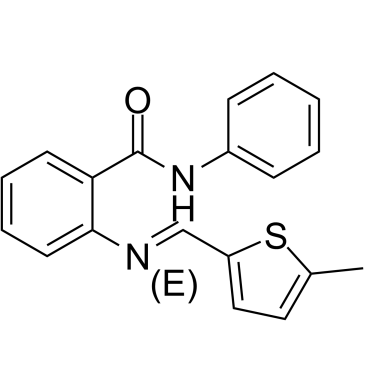Physicochemical Properties
| Molecular Formula | C19H16N2OS |
| Molecular Weight | 320.408143043518 |
| Exact Mass | 320.098 |
| CAS # | 1201652-50-7 |
| PubChem CID | 727405 |
| Appearance | White to yellow solid powder |
| Density | 1.2±0.1 g/cm3 |
| Boiling Point | 461.9±40.0 °C at 760 mmHg |
| Flash Point | 233.2±27.3 °C |
| Vapour Pressure | 0.0±1.1 mmHg at 25°C |
| Index of Refraction | 1.629 |
| LogP | 4.16 |
| Hydrogen Bond Donor Count | 1 |
| Hydrogen Bond Acceptor Count | 3 |
| Rotatable Bond Count | 4 |
| Heavy Atom Count | 23 |
| Complexity | 420 |
| Defined Atom Stereocenter Count | 0 |
| InChi Key | QEGJLRIARJEIPG-UHFFFAOYSA-N |
| InChi Code | InChI=1S/C19H16N2OS/c1-14-11-12-16(23-14)13-20-18-10-6-5-9-17(18)19(22)21-15-7-3-2-4-8-15/h2-13H,1H3,(H,21,22) |
| Chemical Name | 2-[(5-methylthiophen-2-yl)methylideneamino]-N-phenylbenzamide |
| HS Tariff Code | 2934.99.9001 |
| Storage |
Powder-20°C 3 years 4°C 2 years In solvent -80°C 6 months -20°C 1 month Note: This product requires protection from light (avoid light exposure) during transportation and storage. |
| Shipping Condition | Room temperature (This product is stable at ambient temperature for a few days during ordinary shipping and time spent in Customs) |
Biological Activity
| ln Vitro | In HeLa cells expressing GFP-LC3, retro-2 (1 μM; 1-4 hours) induces autophagy and encourages the accumulation of large autophagosomes in the cytoplasm [2]. How the treatment with Retro-2 (1 μM; 0.5–4 hours) gradually raises the amount of LC3-II protein in cells [2]. Transport between autophagosomes and lysosomes is hampered by Retro-2. Autolysosome formation is eliminated by retro-2 [2]. HeLa cell intoxication brought on by ricin and Shiga-like toxins 1 (Stx1) and 2 (Stx2) is inhibited by retro-2 (20 μM; 30 min pretreatment) [1]. Retro-2 prevents non-enveloped viruses like polyomaviruses, papillomaviruses, and adeno-associated viruses from replicating as well as the intracellular parasite Leishmania from invading cells [3]. |
| ln Vivo | Mice given Retro-2 (2–200 mg/kg; intraperitoneal; daily; for 21 days) were largely shielded from ricin exposure that could have been fatal for their noses. Mice were fully shielded against the ricin challenge by 200 mg/kg of retro-2 [1]. |
| Cell Assay |
Autophagy assay [2] Cell Types: HeLa Cell Tested Concentrations: 1 μM Incubation Duration: 1 hour, 2 hrs (hours), 4 hrs (hours) Experimental Results: resulted in a significant increase in the number of small and large vesicles. Western Blot Analysis[2] Cell Types: HeLa Cell Tested Concentrations: 1 μM Incubation Duration: 0.5 hrs (hours), 2 hrs (hours), 4 hrs (hours) Experimental Results: Shows that the abundance of LC3-II protein in cells increases over time. |
| Animal Protocol |
Animal/Disease Models: Female balb/c (Bagg ALBino) mouse (pathogen-free 6 weeks old) were injected with ricin (2 μg/kg) [1] Doses: 2 mg/kg, 10 mg/kg, 20 mg/kg, 200 mg/kg Route of Administration: intraperitoneal (ip) injection; daily; lasted for 21 days. Experimental Results: Protected mice from ricin challenge. |
| References |
[1]. Inhibition of retrograde transport protects mice from lethal ricin challenge. Cell. 2010 Apr 16;141(2):231-42. [2]. Small Trafficking Inhibitor Retro-2 Disrupts the Microtubule-Dependent Trafficking of Autophagic Vacuoles. Front Cell Dev Biol. 2020 Jun 18;8:464. [3]. Retro-2 and its dihydroquinazolinone derivatives inhibit filovirus infection. Antiviral Res. 2018 Jan;149:154-163. |
Solubility Data
| Solubility (In Vitro) | DMSO: ~250 mg/mL (~780.25 mM) |
| Solubility (In Vivo) |
Solubility in Formulation 1: 2.08 mg/mL (6.49 mM) in 10% DMSO + 40% PEG300 + 5% Tween80 + 45% Saline (add these co-solvents sequentially from left to right, and one by one), suspension solution; with sonication. For example, if 1 mL of working solution is to be prepared, you can add 100 μL of 20.8 mg/mL clear DMSO stock solution to 400 μL PEG300 and mix evenly; then add 50 μL Tween-80 to the above solution and mix evenly; then add 450 μL normal saline to adjust the volume to 1 mL. Preparation of saline: Dissolve 0.9 g of sodium chloride in 100 mL ddH₂ O to obtain a clear solution. Solubility in Formulation 2: 2.08 mg/mL (6.49 mM) in 10% DMSO + 90% (20% SBE-β-CD in Saline) (add these co-solvents sequentially from left to right, and one by one), suspension solution; with ultrasonication. For example, if 1 mL of working solution is to be prepared, you can add 100 μL of 20.8 mg/mL clear DMSO stock solution to 900 μL of 20% SBE-β-CD physiological saline solution and mix evenly. Preparation of 20% SBE-β-CD in Saline (4°C,1 week): Dissolve 2 g SBE-β-CD in 10 mL saline to obtain a clear solution. Solubility in Formulation 3: ≥ 2.08 mg/mL (6.49 mM) (saturation unknown) in 10% DMSO + 90% Corn Oil (add these co-solvents sequentially from left to right, and one by one), clear solution. For example, if 1 mL of working solution is to be prepared, you can add 100 μL of 20.8 mg/mL clear DMSO stock solution to 900 μL of corn oil and mix evenly. Solubility in Formulation 4: 10% DMSO+40% PEG300+5% Tween-80+45% Saline: 2.08 mg/mL (6.49 mM) (Please use freshly prepared in vivo formulations for optimal results.) |
| Preparing Stock Solutions | 1 mg | 5 mg | 10 mg | |
| 1 mM | 3.1210 mL | 15.6050 mL | 31.2100 mL | |
| 5 mM | 0.6242 mL | 3.1210 mL | 6.2420 mL | |
| 10 mM | 0.3121 mL | 1.5605 mL | 3.1210 mL |
